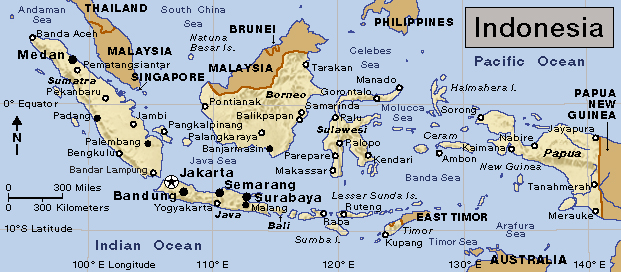Aceh << ah CHEH, AH chay, or ah CHAY >> is a special territory of Indonesia. It lies on the northern tip of the island of Sumatra. Aceh has been a part of Indonesia since that country declared its independence in 1945. By the late 1990’s, however, a growing number of separatists in Aceh called for the province to break its ties with Indonesia.

The capital of Aceh is Banda Aceh. Most of the people of the territory are Muslims. The region is rich in natural resources. It has vast fields of petroleum and natural gas. It also has deposits of gold and silver, and it produces pepper, rubber, and timber.
Aceh was formerly called Atjeh or Achin. It had long been a trading center when the Italian explorer Marco Polo arrived in the area in 1292. By the late 1400’s, it had become an Islamic kingdom. During the 1500’s and early 1600’s, Aceh became the dominant commercial and political center of Sumatra. At the same time, the European powers, especially the Dutch, the Portuguese, and the British, were competing for influence in the region. Aceh declined rapidly after the death of Sultan Iskandar Muda in 1636. In 1874, the Dutch annexed Aceh. However, the Acehnese resisted Dutch rule. The Dutch and Acehnese fought the Aceh War from 1873 to 1903, when the sultan of Aceh surrendered his throne to the Dutch. However, some fighting continued through 1907. The region fell under Japanese control during World War II (1939-1945). Aceh became part of Indonesia in 1945.
In 1959, in response to Acehnese demands for self-rule, the Indonesian government granted Aceh the status of special territory. This status gave Aceh control over its own cultural, educational, and religious affairs. During the 1990’s, however, clashes occurred between Indonesian troops and members of a growing separatist movement in Aceh. The separatists called for independence for Aceh, and they accused the Indonesian military of human rights abuses in the territory. They also claimed that the Indonesian government received an unfair proportion of profits from Aceh’s wealthy oil and gas industry. The government of Indonesia rejected Acehnese calls for independence but promised the region greater autonomy (self-rule) and a larger share of the oil profits.
In 2002, the government and the rebels signed another peace agreement. However, in 2003, the agreement collapsed. Indonesia then imposed martial law in Aceh and began a military campaign against the rebels. In 2004, Indonesia ended martial law but continued its military campaign. It is estimated that at least 15,000 people were killed in the conflict.
In December 2004, a powerful undersea earthquake in the Indian Ocean near Aceh generated a series of large ocean waves called a tsunami. The tsunami’s towering waves killed about 228,000 people in coastal areas of South Asia, Southeast Asia, and East Africa. The tsunami also left millions of people homeless and caused billions of dollars of property damage in the region. Indonesia was by far the hardest hit country, with about 168,000 deaths. The coasts of Aceh were especially devastated. Nearly all of Indonesia’s deaths and damage occurred in Aceh.
After the tsunami, Indonesian government forces and Acehnese rebels declared an informal truce to allow aid to reach Aceh. In 2005, leaders of the two sides held a series of talks in Finland. They signed a peace agreement in August 2005. In December, the rebels dissolved their military arm and gave up their weapons to international officials as part of the agreement. That same month, the Indonesian government withdrew over 24,000 troops from Aceh. The Acehnese also gained the right to hold elections in the agreement, and the first elections were held in December 2006.

